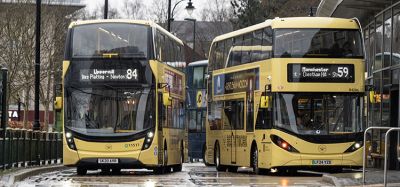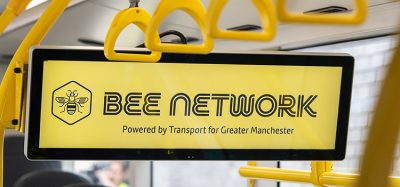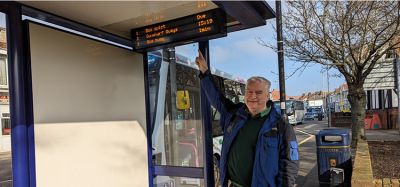Successful Real Time Passenger Information in Oslo
- Like
- Digg
- Del
- Tumblr
- VKontakte
- Buffer
- Love This
- Odnoklassniki
- Meneame
- Blogger
- Amazon
- Yahoo Mail
- Gmail
- AOL
- Newsvine
- HackerNews
- Evernote
- MySpace
- Mail.ru
- Viadeo
- Line
- Comments
- Yummly
- SMS
- Viber
- Telegram
- Subscribe
- Skype
- Facebook Messenger
- Kakao
- LiveJournal
- Yammer
- Edgar
- Fintel
- Mix
- Instapaper
- Copy Link
Posted: 30 April 2008 | Jarl Eliassen, Managing Director, Trafikanten AS | No comments yet
Trafikanten AS is responsible for customer services and travel information in the greater Oslo-area for all modes of public transport. The services are provided free-of-charge to the public through service-centres, call-centres, Internet, WAP and SMS on behalf of the PTA’s and all PT operators in the area. The geographical area of Trafikanten AS is continually growing and the web-based services and online travel planner now covers all eight counties in the South-Eastern part of Norway.
Trafikanten AS is responsible for developing and maintaining a variety of public services relating to their role in Public Transport. In 2004, Trafikanten AS started introducing Real Time Passenger Information (RTPI) for their customers. By the second quarter of 2008, more than 95% of the Oslo fleet of buses and all trams will be connected to this RTPI system.
Trafikanten AS is responsible for customer services and travel information in the greater Oslo-area for all modes of public transport. The services are provided free-of-charge to the public through service-centres, call-centres, Internet, WAP and SMS on behalf of the PTA’s and all PT operators in the area. The geographical area of Trafikanten AS is continually growing and the web-based services and online travel planner now covers all eight counties in the South-Eastern part of Norway. Trafikanten AS is responsible for developing and maintaining a variety of public services relating to their role in Public Transport. In 2004, Trafikanten AS started introducing Real Time Passenger Information (RTPI) for their customers. By the second quarter of 2008, more than 95% of the Oslo fleet of buses and all trams will be connected to this RTPI system.
Trafikanten AS is responsible for customer services and travel information in the greater Oslo-area for all modes of public transport. The services are provided free-of-charge to the public through service-centres, call-centres, Internet, WAP and SMS on behalf of the PTA’s and all PT operators in the area. The geographical area of Trafikanten AS is continually growing and the web-based services and online travel planner now covers all eight counties in the South-Eastern part of Norway.
Trafikanten AS is responsible for developing and maintaining a variety of public services relating to their role in Public Transport. In 2004, Trafikanten AS started introducing Real Time Passenger Information (RTPI) for their customers. By the second quarter of 2008, more than 95% of the Oslo fleet of buses and all trams will be connected to this RTPI system.
There are 1.1 million inhabitants in the greater Oslo-area and 2.2 million in the total area covered by the travel planner of Trafikanten AS. The company served more than 16 million customers in 2007 via their different distribution channels. The journey planner on the Internet handled approximately 90% of all enquiries.
Assignment of tasks
Like every major city, Oslo faces the challenge of coping with the increasing mobility of their population. Due to the constantly growing volume of traffic, the region of Oslo has invested massively in the expansion of its road networks. However, the modernisation of public transport has not been equally supported. As a consequence, the responsible public authorities were confronted with the situation that more and more travellers counted on individual transport and less and less on public transport – with all the negative impacts on the environment and on their quality of life. The overall market share of public transport has decreased in Oslo, as in many other major cities.
One of the important measures taken in order to make the public transport competitive again, is the introduction of a new and reliable passenger information system.
The lack of exact information about the offered benefits was identified as the main key force of public transport. A modern telematics system should, in the future, not only provide RTPI, but also optimise the operational performance and then enable the Oslo transport authority to make their service more attractive, faster and efficient.
In 2004, Trafikanten AS assigned the German firm INIT with the implementation of a telematics system for public transport in the Oslo region. Besides the Intermodal Control System and the corresponding vehicle IT-platforms, the contract comprised the equipment with a traffic signal priority system and passenger information.
Improved disposition
The Intermodal Transport Control system MOBILE-ITCS supports dispatchers in Oslo in monitoring and optimising the operational performance. With information graphics and corresponding messages the Intermodal Transport Control System alerts the dispatchers at an early stage in case of any disturbances in the operational performance and therefore allows for a timely intervention/reaction. The problems can be solved or avoided with dispatching measures. They also ensure that schedules are met and transfers secured.
Data transfer for schedule data and data provision for vehicles and MOBILE-ITCS is managed by the planning and data management system called MOBILE-PLAN.
Modern communication
To enable data to be processed without delay, every vehicle is permanently radio-linked using GPRS technology. The vehicles communicate with the central control office as soon as they exceed defined limits in the schedule or when messages have to be exchanged. The transport company benefits from cost savings since it was not required to set up and maintain its own radio infrastructure. The current decline in mobile radio tariffs confirms the decision for this communication technology.
At the end of every day, statistical vehicle data is uploaded to the control centre using WLAN, as well as downloading data and software. A system for exchange and interpretation of statistical data evaluates the collected data and compares them to the planned data. The operational analysis shows vehicle profiles or if the limit value is exceeded. Like this, Trafikanten AS is able to monitor their complex daily operations and optimise their operational performance. Statistical analysis of the trip and journey data is also carried out for the involved Public Transport Authorities and the individual operators.
On-board computers with touch-screen interface
The necessary counterpart in the vehicle is the on-board computer, called COPILOTpc. This vehicle IT-platform, based on the operating system Windows XP embedded®, controls all the telematics functions, organises the radio communication with the central control centre, and calculates the location and the current schedule situation with the help of GPS (Global Positioning System) equipment.
The on-board computer is operated by a mobile data terminal with touch-screen, offering a maximum of support for the drivers. They have all necessary information available at a legible glance and all key features are easy to use. Approximately 780 vehicles have been equipped for the system.
Rapid ITS implementation
In 2004, INIT implemented a complete operational pilot for Oslo’s ITS system in less than seven months. This included the implementation of the Intermodal Transport Control System as well as the installation of wayside Passenger Information Displays at stops. More than 50 buses and trams were included in the successful pilot scheme.
Traffic signal priority was also tested in the pilot and this part of the system has since played an even more important part in the project, enhancing the quality of service. Green light requests via data radio ensure that all buses and trams have the right of way at more than 125 crossings.
Always up-to-date
The ITS system considerably improves passenger information. On-board-announcements and LED displays, conveniently inform passengers about the next stop. Nearly all important downtown stops have been equipped with wayside passenger information displays. At these stops, passengers always know the exact arrival time of the next bus or tram.
This information is not only available at bus stops, but also at home or in the office through a system-integrated Internet interface. Moreover, passengers can receive requested information about the next departures even via mobile phone.
The real time information service has led to a considerable improvement in customer satisfaction.
RTPI in the Metro system
In 2008, the RTPI system has been extended to the Oslo underground network. After having introduced RTPI for virtually the whole bus and tram network in the metropolitan area, it was considered important to provide reliable RTPI to the customers on Oslo’s heaviest public transport mode, the underground Metro system.
More than 238,000 daily passenger trips are counted on the Metro. The network consists of four basic lines with more than 100 stations. The basic headway is 15 minutes. All lines meet in a common tunnel section running through the centre of Oslo, providing a 3-4 minute headway on the busiest part of the network.
The same central platform as for the existing system for buses and trams. For the real time data provision, two alternatives were considered:
- Vehicle computers in Metro trains (as for the existing system)
- Data provision from the Central Management and Control System for the Metro network
Vehicle computers had been proven to work in the existing system. However, they had proved to work best given GPS coverage (unavailable in the Metro network’s ubiquitous tunnels). They would also account for a substantial cost for deployment and maintenance.
Luckily, a real time interface to the Westinghouse CMCS was already available. The CMCS knows all train positions by their assigned track circuits in the interlocking system, and the interface had been developed on demand of an earlier information system.
In January 2008, the Metro system was officially launched in Trafikanten’s RTPI services on web and mobile units (WAP and SMS). Simultaneously, until May 2008, testing of RTPI displays from four different suppliers is ongoing.
Focus on recognition and reliability
Continuously throughout the RTPI project, Trafikanten has been focusing on making the RTPI recognisable for the customer, regardless of which format or distribution channel is chosen.
This means that passengers on the Metro will already be acquainted with the layout and design of RTPI messages due to their experience from the signs for buses and trams.
Related topics
Travel & Passenger Information
Issue
Issue 2 2008








